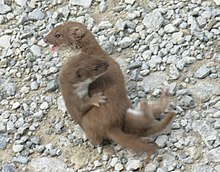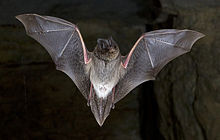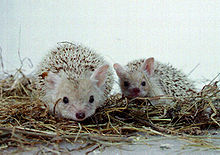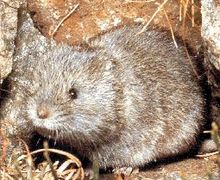List of mammals of Azerbaijan
Appearance
| Part of a series on the |
| Wildlife of Azerbaijan |
|---|
 |
|
|
This list shows the IUCN Red List status of mammal species occurring in Azerbaijan. One species is endangered, five are vulnerable, and 11 are near threatened. The following tags are used to highlight each species' global conservation status as assessed on the respective IUCN Red List published by the International Union for Conservation of Nature:
| EX | Extinct | No reasonable doubt that the last individual has died. |
| EW | Extinct in the wild | Known only to survive in captivity or as a naturalized populations well outside its previous range. |
| CR | Critically endangered | The species is in imminent risk of extinction in the wild. |
| EN | Endangered | The species is facing an extremely high risk of extinction in the wild. |
| VU | Vulnerable | The species is facing a high risk of extinction in the wild. |
| NT | Near threatened | The species does not meet any of the criteria that would categorise it as risking extinction but it is likely to do so in the future. |
| LC | Least concern | There are no current identifiable risks to the species. |
| DD | Data deficient | There is inadequate information to make an assessment of the risks to this species. |
Order: Artiodactyla


- Family: Bovidae
- Genus: Bison
- European bison, B. bonasus NT reintroduced[1]
- Caucasian wisent, B. b. caucasicus EX
- European bison, B. bonasus NT reintroduced[1]
- Genus: Capra
- Wild goat, C. aegagrus NT[2]
- East Caucasian tur, C. cylindricornis NT[3]
- Genus: Gazella
- Goitered gazelle, G. subgutturosa VU[4]
- Genus: Ovis
- Mouflon, O. gmelini NT[5]
- Armenian mouflon, O. g. gmelini
- Mouflon, O. gmelini NT[5]
- Genus: Rupicapra
- Genus: Bison
- Family: Cervidae
- Family: Cervidae
- Family: Suidae
Order: Carnivora




- Family: Canidae
- Genus: Canis
- Golden jackal, C. aureus LC[10]
- European jackal, C. a. moreoticus
- Gray wolf, C. lupus LC[11]
- Steppe wolf, C. l. campestris
- Golden jackal, C. aureus LC[10]
- Genus: Vulpes
- Genus: Canis
- Family: Felidae
- Genus: Felis
- Jungle cat, F. chaus LC[13]
- European wildcat, F. silvestris LC[14]
- African wildcat, F. lybica LC[15]
- Genus: Lynx
- Eurasian lynx, L. lynx LC[16]
- Caucasian lynx, L. l. dinniki
- Eurasian lynx, L. lynx LC[16]
- Genus: Panthera
- Leopard, P. pardus VU[17]
- Persian leopard, P. p. tulliana EN[17]
- Leopard, P. pardus VU[17]
- Genus: Felis
- Family: Ursidae
- Genus: Ursus
- Brown bear, U. arctos LC[18]
- Genus: Ursus
- Family: Procyonidae
- Genus: Procyon
- Common raccoon, P. lotor LC introduced
- Genus: Procyon
- Family: Hyaenidae
- Genus: Hyaena
- Striped hyena, H. hyaena NT[19]
- Genus: Hyaena
- Family: Mustelidae
- Genus: Lutra
- European otter, L. lutra NT[20]
- Genus: Martes
- Beech marten, M. foina LC[21]
- European pine marten, M. martes LC[22]
- Genus: Meles
- Caucasian badger, M. canescens NE
- Genus: Mustela
- Stoat, M. erminea LC[23]
- Least weasel, M. nivalis LC[24]
- Genus: Vormela
- Marbled polecat, V. peregusna VU[25]
- Genus: Lutra
- Family: Phocidae
- Genus: Pusa
- Caspian seal, P. caspica EN
- Genus: Pusa
Order: Chiroptera



- Family: Vespertilionidae
- Genus: Barbastella
- Western barbastelle, B. barbastellus NT[26]
- Asian barbastelle, B. leucomelas LC
- Genus: Eptesicus
- Botta's serotine, E. bottae LC
- Northern bat, E. nilssonii LC
- Serotine bat, E. serotinus LC
- Genus: Hypsugo
- Savi's pipistrelle, H. savii LC[27]
- Genus: Miniopterus
- Common bent-wing bat, M. schreibersii VU[28]
- Genus: Myotis
- Bechstein's bat, M. bechsteini NT[29]
- Lesser mouse-eared bat, M. blythii LC[30]
- Geoffroy's bat, M. emarginatus LC[31]
- Whiskered bat, M. mystacinus LC[32]
- Natterer's bat, M. nattereri LC[33]
- Genus: Nyctalus
- Lesser noctule, N. leisleri LC[34]
- Common noctule, N. noctula LC[35]
- Genus: Plecotus
- Brown long-eared bat, P. auritus LC[36]
- Grey long-eared bat, P. austriacus LC
- Genus: Pipistrellus
- Kuhl's pipistrelle, P. kuhlii LC
- Nathusius' pipistrelle, P. nathusii LC[37]
- Common pipistrelle, P. pipistrellus LC
- Soprano pipistrelle, P. pygmaeus LC
- Genus: Vespertilio
- Parti-coloured bat, V. murinus LC[38]
- Genus: Barbastella
- Family: Molossidae
- Genus: Tadarida
- European free-tailed bat, T. teniotis LC[39]
- Genus: Tadarida
- Family: Rhinolophidae
- Genus: Rhinolophus
- Blasius's horseshoe bat, R. blasii LC[40]
- Mediterranean horseshoe bat, R. euryale NT[41]
- Greater horseshoe bat, R. ferrumequinum LC[42]
- Lesser horseshoe bat, R. hipposideros LC[43]
- Mehely's horseshoe bat, R. mehelyi VU[44]
- Genus: Rhinolophus
Order: Eulipotyphla

- Family: Erinaceidae
- Genus: Erinaceus
- Southern white-breasted hedgehog, E. concolor LC
- Genus: Hemiechinus
- Long-eared hedgehog, H. auritus LC
- Genus: Erinaceus

- Family: Soricidae
- Genus: Crocidura
- Caspian shrew, C. caspica DD
- Gueldenstaedt's shrew, C. gueldenstaedti LC
- Bicolored shrew, C. leucodon LC
- Genus: Neomys
- Transcaucasian water shrew, N. teres LC
- Genus: Suncus
- Etruscan shrew, S. etruscus LC
- Genus: Crocidura
- Family: Talpidae
- Genus: Talpa
- Levant mole, T. levantis LC
- Genus: Talpa
Order: Lagomorpha
- Family: Leporidae
- Genus: Lepus
- European hare, L. europaeus LC[45]
- Genus: Lepus
Order: Rodentia





- Family: Calomyscidae
- Genus: Calomyscus
- Urar mouse-like hamster, C. urartensis LC
- Genus: Calomyscus
- Family: Cricetidae
- Genus: Arvicolinae
- European water vole, A. amphibius LC[46]
- Genus: Chionomys
- Caucasian snow vole, C. gud LC
- European snow vole, C. nivalis LC
- Robert's snow vole, C. roberti LC
- Genus: Cricetulus
- Grey hamster, C. migratorius LC
- Genus: Ellobius
- Transcaucasian mole vole, E. lutescens LC
- Genus: Mesocricetus
- Turkish hamster, M. brandti NT
- Genus: Microtus
- Common vole, M. arvalis LC
- Daghestan pine vole, M. daghestanicus LC
- Major's pine vole, M. majori LC
- Schelkovnikov's pine vole, M. schelkovnikovi LC
- Social vole, M. socialis LC
- Genus: Arvicolinae
- Family: Dipodidae
- Genus: Allactaga
- Small five-toed jerboa, A. elater LC
- Williams' jerboa, A. williamsi LC
- Genus: Allactaga
- Family: Gliridae
- Genus: Dryomys
- Forest dormouse, D. nitedula LC
- Genus: Glis
- European edible dormouse, G. glis LC
- Iranian edible dormouse, G. persicus NE
- Genus: Dryomys
- Family: Hystricidae
- Genus: Hystrix
- Indian crested porcupine, H. indica LC[47]
- Genus: Hystrix
- Family: Muridae
- Genus: Apodemus
- Striped field mouse, A. agrarius LC
- Caucasus field mouse, A. hyrcanicus DD
- Black Sea field mouse, A. ponticus LC
- Ural field mouse, A. uralensis LC
- Steppe field mouse, A. witherbyi LC
- Genus: Meriones
- Libyan jird, M. libycus LC
- Midday jird, M. meridianus LC
- Persian jird, M. persicus LC
- Tristram's jird, M. tristami LC
- Vinogradov's jird, M. vinogradovi LC
- Genus: Micromys
- Eurasian harvest mouse, M. minutus LC
- Genus: Mus
- House mouse, M. musculus LC[48]
- Genus: Rattus
- Genus: Apodemus
- Family: Myocastoridae
- Family: Sciuridae
- Genus: Sciurus
- Caucasian squirrel, S. anomalus LC
- Red squirrel, S. vulgaris LC[50]
- Genus: Sciurus
Locally extinct
The following species are locally extinct in the country:
- Cheetah, Acinonyx jubatus[51]
- Moose, Alces alces[52]
- Wild horse, Equus ferus[53]
- Onager, Equus hemionus[54]
- Pallas's cat, Otocolobus manul possibly extirpated[55]
- Lion, Panthera leo[56]
- Tiger, Panthera tigris[57]
See also
References
- ^ Caucasus bisons released into Azerbaijan`s nature
- ^ Weinberg, P. & Ambarli, H. (2020). "Capra aegagrus". IUCN Red List of Threatened Species. 2020: e.T3786A22145942.
- ^ Lortkipanidze, B. & Weinberg, P. (2020). "Capra cylindricornis". IUCN Red List of Threatened Species. 2020: e.T3795A91287260.
- ^ IUCN SSC Antelope Specialist Group (2017). "Gazella subgutturosa". IUCN Red List of Threatened Species. 2017: e.T8976A50187422.
- ^ Michel, S. & Ghoddousi, A. (2020). "Ovis gmelini". IUCN Red List of Threatened Species. 2020: e.T54940218A22147055.
- ^ Anderwald, P.; Ambarli, H.; Avramov, S.; Ciach, M.; Farkas, A.; Jovanovic, M.; Papaioannou, H.; Peters, W.; Sarasa, M.; Šprem, N.; Weinberg, P. & Willisch, C. (2020). "Rupicapra rupicapra". IUCN Red List of Threatened Species. 2020: e.T39255A22149561.
- ^ a b Lovari, S.; Herrero, J.; Masseti, M.; Ambarli, H.; Lorenzini, R. & Giannatos, G. (2016). "Capreolus capreolus". IUCN Red List of Threatened Species. 2016: e.T42395A22161386.
- ^ Lovari, S.; Lorenzini, R.; Masseti, M.; Pereladova, O.; Carden, R.F.; Brook, S.M. & Mattioli, S. (2018). "Cervus elaphus". IUCN Red List of Threatened Species. 2018: e.T55997072A142404453.
- ^ Keuling, O. & Leus, K. (2019). "Sus scrofa". IUCN Red List of Threatened Species. 2019: e.T41775A44141833.
- ^ Hoffmann, M.; Arnold, J.; Duckworth, J. W.; Jhala, Y.; Kamler, J. F. & Krofel, M. (2018). "Canis aureus". IUCN Red List of Threatened Species. 2018: e.T118264161A46194820.
- ^ Boitani, L.; Phillips, M. & Jhala, Y. (2018). "Canis lupus". IUCN Red List of Threatened Species. 2018: e.T3746A119623865.
- ^ Hoffmann, M. & Sillero-Zubiri, C. (2016). "Vulpes vulpes". IUCN Red List of Threatened Species. 2016: e.T23062A46190249.
- ^ Gray, T.N.E.; Timmins, R.J.; Jathana, D.; Duckworth, J.W.; Baral, H. & Mukherjee, S. (2016). "Felis chaus". IUCN Red List of Threatened Species. 2016: e.T8540A50651463.
- ^ Gerngross, P.; Ambarli, H.; Angelici, F.M.; Anile, S.; Campbell, R.; Ferreras de Andres, P.; Gil-Sanchez, J.M.; Götz, M.; Jerosch, S.; Mengüllüoglu, D.; Monterosso, P. & Zlatanova, D. (2022). "Felis silvestris". IUCN Red List of Threatened Species. 2022: e.T181049859A181050999. doi:10.2305/IUCN.UK.2022-1.RLTS.T181049859A181050999.en. Retrieved 3 August 2022.
- ^ Ghoddousi, A.; Belbachir, F.; Durant, S.M.; Herbst, M. & Rosen, T. (2022). "Felis lybica". IUCN Red List of Threatened Species. 2022: e.T131299383A154907281. doi:10.2305/IUCN.UK.2022-1.RLTS.T131299383A154907281.en.
- ^ Breitenmoser, U.; Breitenmoser-Würsten, C.; Lanz, T.; von Arx, M.; Antonevich, A.; Bao, W. & Avgan, B. (2015). "Lynx lynx". IUCN Red List of Threatened Species. 2015: e.T12519A121707666.
- ^ a b Stein, A. B.; Athreya, V.; Gerngross, P.; Balme, G.; Henschel, P.; Karanth, U.; Miquelle, D.; Rostro, S.; Kamler, J.F. & Laguardia, A. (2016). "Panthera pardus". IUCN Red List of Threatened Species. 2016: e.T15954A160698029.
- ^ McLellan, B. N.; Proctor, M. F.; Huber, D. & Michel, S. (2017). "Ursus arctos". IUCN Red List of Threatened Species. 2017: e.T41688A121229971.
- ^ AbiSaid, M. & Dloniak, S.M.D. (2015). "Hyaena hyaena". IUCN Red List of Threatened Species. 2015: e.T10274A45195080.
- ^ Roos, A.; Loy, A.; de Silva, P.; Hajkova, P. & Zemanová, B. (2015). "Lutra lutra". IUCN Red List of Threatened Species. 2015: e.T12419A21935287.
- ^ Abramov, A.V.; Kranz, A.; Herrero, J.; Krantz, A.; Choudhury, A. & Maran, T. (2016). "Martes foina". IUCN Red List of Threatened Species. 2016: e.T29672A45202514.
- ^ Herrero, J.; Kranz, A.; Skumatov, D.; Abramov, A.V.; Maran, T. & Monakhov, V.G. (2016). "Martes martes". IUCN Red List of Threatened Species. 2016: e.T12848A45199169.
- ^ Reid, F.; Helgen, K. & Kranz, A. (2016). "Mustela erminea". IUCN Red List of Threatened Species. 2016: e.T29674A45203335.
- ^ McDonald, R. A.; Abramov, A. V.; Stubbe, M.; Herrero, J.; Maran, T.; Tikhonov, A.; Cavallini, P.; Kranz, A.; Giannatos, G.; Kryštufek, B. & Reid, F. (2019). "Mustela nivalis". IUCN Red List of Threatened Species. 2019: e.T70207409A147993366.
- ^ Abramov, A.V.; Kranz, A. & Maran, T. (2016). "Vormela peregusna". IUCN Red List of Threatened Species. 2016: e.T29680A45203971.
- ^ Piraccini, R. (2016). "Barbastella barbastellus". IUCN Red List of Threatened Species. 2016: e.T2553A22029285.
- ^ Hutson, A. M.; Spitzenberger, F.; Juste, J.; Aulagnier, S.; Palmeirim, J.; Paunovic, M. & Karatas, A. (2010). "Hypsugo savii". IUCN Red List of Threatened Species. 2010: e.T44856A10955205.
- ^ Gazaryan, S.; Bücs, S. & Çoraman, E. (2020). "Miniopterus schreibersii". IUCN Red List of Threatened Species. 2020: e.T81633057A151216401.
- ^ Paunović, M. (2019). "Myotis bechsteinii". IUCN Red List of Threatened Species. 2019: e.T14123A22053752.
- ^ Juste, J. & Paunović, M. (2016). "Myotis blythii". IUCN Red List of Threatened Species. 2016: e.T14124A22053297.
- ^ Piraccini, R. (2016). "Myotis emarginatus". IUCN Red List of Threatened Species. 2016: e.T14129A22051191.
- ^ Coroiu, I. (2016). "Myotis mystacinus". IUCN Red List of Threatened Species. 2016: e.T14134A22052250.
- ^ Gazaryan, S.; Kruskop, S.V. & Godlevska, L. (2020). "Myotis nattereri". IUCN Red List of Threatened Species. 2020: e.T85733032A22052584.
- ^ Juste, J. & Paunović, M. (2016). "Nyctalus leisleri". IUCN Red List of Threatened Species. 2016: e.T14919A22016159.
- ^ Csorba, G. & Hutson, A.M. (2016). "Nyctalus noctula". IUCN Red List of Threatened Species. 2016: e.T14920A22015682.
- ^ Gazaryan, S.; Kruskop, S.V. & Godlevska, L. (2021) [errata version of 2020 assessment]. "Plecotus auritus". IUCN Red List of Threatened Species. 2020: e.T85535522A195861341.
- ^ Hutson, A. M.; Spitzenberger, F.; Juste, J.; Aulagnier, S.; Palmeirim, J.; Karatas, A. & Paunovic, M. (2010). "Pipistrellus nathusii". IUCN Red List of Threatened Species. 2010: e.T17316A6966886.
- ^ Coroiu, I. (2016). "Vespertilio murinus". IUCN Red List of Threatened Species. 2016: e.T22947A22071456.
- ^ Benda, P. & Piraccini, R. (2016). "Tadarida teniotis". IUCN Red List of Threatened Species. 2016: e.T21311A22114995.
- ^ Taylor, P. (2016). "Rhinolophus blasii". IUCN Red List of Threatened Species. 2016: e.T19515A21972073.
- ^ Juste, J. & Alcaldé, J. (2016). "Rhinolophus euryale". IUCN Red List of Threatened Species. 2016: e.T19516A21971185.
- ^ Piraccini, R. (2016). "Rhinolophus ferrumequinum". IUCN Red List of Threatened Species. 2016: e.T19517A21973253.
- ^ Taylor, P. (2016). "Rhinolophus hipposideros". IUCN Red List of Threatened Species. 2016: e.T19518A21972794.
- ^ Alcaldé, J.; Benda, P. & Juste, J. (2016). "Rhinolophus mehelyi". IUCN Red List of Threatened Species. 2016: e.T19519A21974380.
- ^ Hacklande, K.; Schai-Braun, S. (2019). "Lepus europaeus". IUCN Red List of Threatened Species. 2019: e.T41280A45187424.
- ^ Batsaikhan, N.; Henttonen, H.; Meinig, H.; Shenbrot, G., Bukhnikashvili, A., Hutterer, R., Kryštufek, B., Yigit, N., Mitsain, G. & Palomo, L. (2016). "Arvicola amphibius". IUCN Red List of Threatened Species. 2016: e.T2149A115060819.
{{cite journal}}: CS1 maint: multiple names: authors list (link) - ^ Amori, G.; Hutterer, R.; Kryštufek, B.; Yigit, N.; Mitsain, G. & Palomo, L. J. (2016). "Hystrix indica". IUCN Red List of Threatened Species. 2016: e.T10751A115099509.
- ^ Musser, G.; Hutterer, R.; Kryštufek, B.; Yigit, N. & Mitsain, G. (2016). "Mus musculus". IUCN Red List of Threatened Species. 2016: e.T13972A115117618.
- ^ Ruedas, L. (2016). "Rattus norvegicus". IUCN Red List of Threatened Species. 2016: e.T19353A165118026.
- ^ Amori, G.; Hutterer, R.; Kryštufek, B.; Yigit, N.; Mitsain, G. & Muñoz, L. J. P. (2010). "Sciurus vulgaris". IUCN Red List of Threatened Species. 2010: e.T20025A9136220.
- ^ Heptner, V. G., Sludskij, A. A. (1992) [1972]. "Cheetah, Pardus". Mlekopitajuščie Sovetskogo Soiuza. Moskva: Vysšaia Škola [Mammals of the Soviet Union. Volume II, Part 2. Carnivora (Hyaenas and Cats)]. Washington DC: Smithsonian Institution and the National Science Foundation. pp. 702–733.
- ^ Niedziałkowska, M. Phylogeography of European moose (Alces alces) based on contemporary mtDNA data and archaeological records. Mamm Biol 84, 35–43 (2017). https://doi.org/10.1016/j.mambio.2017.01.004
- ^ Vereshchagin, Nikolaĭ Kuzʹmich (1967). The Mammals of the Caucasus. Israel Program for Scientific Translations. pp. 1–816.
- ^ Kaczensky, P.; Lkhagvasuren, B.; Pereladova, O.; Hemami, M. & Bouskila, A. (2020). "Equus hemionus". IUCN Red List of Threatened Species. 2020: e.T7951A166520460.
- ^ Ross, S.; Barashkova, A.; Dhendup, T.; Munkhtsog, B.; Smelansky, I.; Barclay, D. & Moqanaki, E. (2020). "Otocolobus manul". IUCN Red List of Threatened Species. 2020: e.T15640A162537635.
- ^ Heptner, V. G.; Sludskii, A. A. (1992) [1972]. "Lion". Mlekopitajuščie Sovetskogo Soiuza. Moskva: Vysšaia Škola [Mammals of the Soviet Union, Volume II, Part 2]. Washington DC: Smithsonian Institution and the National Science Foundation. pp. 83–95. ISBN 978-90-04-08876-4.
- ^ Heptner, V. G. & Sludskij, A. A. (1992) [1972]. "Tiger". Mlekopitajuščie Sovetskogo Soiuza. Moskva: Vysšaia Škola [Mammals of the Soviet Union. Volume II, Part 2. Carnivora (Hyaenas and Cats)]. Washington DC: Smithsonian Institution and the National Science Foundation. pp. 95–202.
